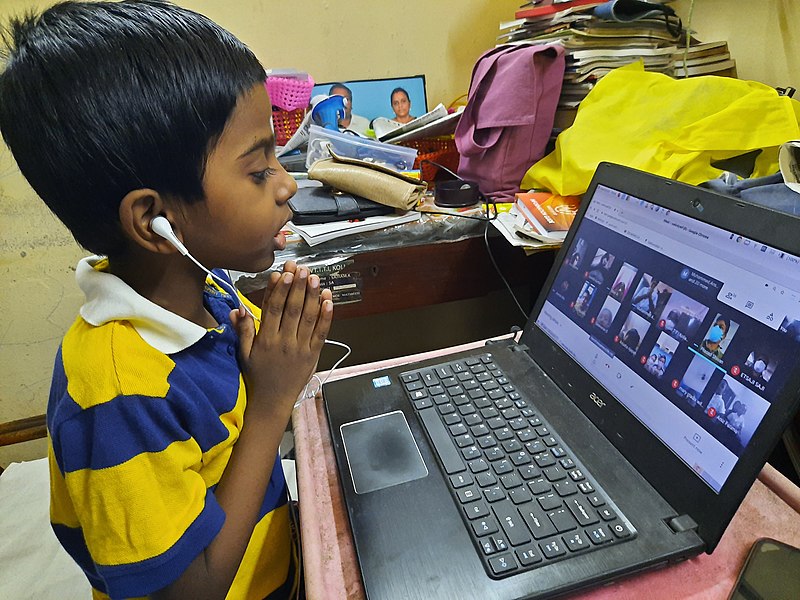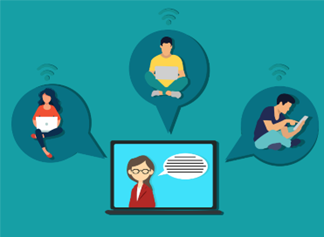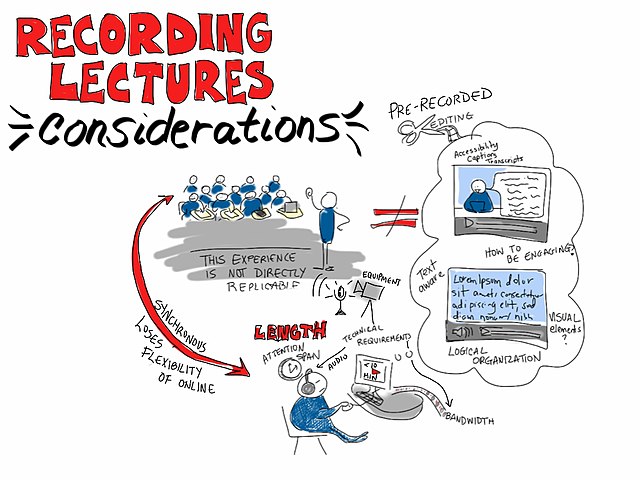-Vagish K Jha
Even though the overall situation seems to be limping back to normalcy, a sense of uncertainty is still writ large in the face of our times. The schools have opened in a phased manner. The Next Wave, experts fear, may knock on our doors again. The future is always unknown. But when the present gets into turmoil, incertitude about the future deepens further.
The tension, you would agree, is palpable. The school community in general is looking forward into a haze trying to make sense. Let us draw attention to three areas that need to be highlighted as we tread cautiously into what is known as the ‘new normal’ of the digital teaching-learning ecosystem.
The first area is the tension between new tools and old practices. As COVID-19 struck like a Tsunami, the schools woke up quickly after the initial daze. Teachers valiantly faced the laptops and mobiles and taught like they did in their physical classes. They did what they knew; teach face-to-face. Much water has flown into the Ganges since then. About two years in the vortex, today we have gained several crucial insights.

One of the most prominent ones has been that using old practices with new tools does not work. Though some of us are still in denial, hoping to keep doing the old way without recognizing that the world of education has changed around us, we need to remind ourselves of what the great educational philosopher John Dewey[1] said: “The most notable distinction between living and inanimate things is that the former maintain themselves by renewal. Continuity of life means continual readaptation of the environment to the needs of living organisms.” Teaching, therefore, needs to re-adapt because our teaching must reflect and connect with how our students learn today. More importantly, it needs to resonate with the world students will emerge into. So, to go back to the old ways would be to ‘rob them of tomorrow’. But what does this mean?
This brings us to the second important aspect. We need to remember that technology is a tool to achieve certain goals. It is not a panacea. This simply means that technology must service the learning model. To think of augmenting digital infrastructure alone without a cogently worked out plan in place for how it’s to be deployed or what new teaching-learning approaches it would support, will be infructuous. We also need to be clear that technology is not just a carrier. Using technology to amplify the way face-to-face teaching happens is to squander the opportunity provided by the digital environment.
This argument is being offered that technology alone is sufficient to manage teaching learning. This, even if theoretically and practically possible, will not go in the interest of the overall purpose of education. Technology cannot substitute schools or replace teachers. Not yet! Schools and teachers play a much greater role than just providing physical space and human touch.
Those envisaging the future to be an AI-led education need to pay heed to what Brian Christian calls the ‘alignment problem’. In his latest book by the same name, he brilliantly sums up the scenario of us being reduced to ‘sorcerer’s apprentice’[2] with an unhindered growth of machine learning. An entirely AI based education can solve the problem of intelligence but leaves gaping holes in critical and affective areas. Schools and teachers play a crucial role here.

Thus, the way forward is to think in terms of “teachers and technology” and realise that tech-enabled solutions create greater impact only when adopted and effectively infused in the process of teaching by the teachers.
The third aspect follows from this. It is a question that many may find strange before giving it proper thought – Are you using the tool or is the tool using you? Most of the talk about building a teacher’s capacity revolves around giving them the knowledge of how to use certain digital tools. In this perspective there are two inherent assumptions. One, a teacher is a mere consumer of technological tools and platforms. Second, a teacher is just a transmission or delivery agent. Both are problematic.
The sudden disruption caused by the pandemic has created an unprecedented pressure on teachers to prove themselves. This pressure to keep themselves relevant has resulted in a child-like enthusiasm for using a ‘new toy’ of digital tools handed over to them or grabbed by them. Nationwide, or perhaps globally, teachers are on a spree of ‘creating’ lessons using one or the other digital tool and sharing them with students on the available platforms. Schools, in their eagerness to prove that they are firmly riding the digital bandwagon, flaunt that their teachers have created YouTube tube channels of lessons on various subjects.
There is a glut of such basic digital resources produced by the umpteenth number of teachers – more of the same or similar kinds. We tried to test this on 21st January 2023 at 5.35pm IST )by typing ‘Newton’s law of motion’ on YouTube and it threw up 5,81,00,000 in (0.60 seconds) and the ‘Indus Valley civilization’ we got 1,01,00,000 results (0.50 seconds). We had done the same earlier on (on 15th July 2021 at 12.16 pm) and we got 6,96,000 and 2,19,000 results respectively for these terms. The growth rate can be easily calculated.

Just look for the data on how much content is being created on YouTube.[3] As per one report, “The number of video content hours uploaded to YouTube every 60 seconds grew by 40% between 2014 and 2019.” It would have multiplied exponentially when the entire teaching community got on to the YouTube band wagon. But where are the figures? It is a telling example of how much of the ‘latest’ information one can find on the internet!
Given this, there are some other crucial questions to ask. If we already have so many resources on content areas already available, why are we creating more of the same? Another important aspect is that as teachers go on creating these resources two key questions are not being asked: Do you do what a tool allows you to do? Or you decide to select a tool to do what you want to do?
The fact is that by using a new tool like a new toy, we end up creating something basic which depends on the type of tool used and how much we know about how to use that tool. The level of one’s proficiency with a tool constrains the quality and nature of creation.
Another related question that needs to be asked about this process is that – Is there any pedagogical innovation happening?
Most unlikely.

If the focus of a teacher is to learn the basic functions of a digital tool or platform, they would be doing what a tool will allow them to do or what they know to do with this tool. Constant and fast upgradation in tools and platforms also requires them to be on their toes and well informed to exploit the full potential offered by the tool. The most important loss in this process is that the pedagogical advantage a teacher may otherwise have gets diluted while using a digital tool under duress or even out of curiosity.
In the thick of the pandemic, we missed asking another pertinent question. In the extraordinary situation, where a teacher was stressed about conducting online classes, what was important was not so much about how did they create YouTube videos or shared them on WhatsApp. The core issue was whether a teacher developed abilities by which an existing resource can be used, modified, or adapted effectively. We missed this opportunity.
Rather than trying to tell them how to use ‘Google Meet’ or ‘Zoom’, the focus needed to be on honing the digital pedagogy, their ability to create and use contextualized digital resources efficaciously. It is the idea of technological infusion where pedagogical priorities guide the decisions about which tool to use for achieving specific goals of a lesson. Otherwise, most of a teacher’s attention goes to managing the ‘digital monster’ rather than achieving the purpose of education, one of which is the learning outcomes.
This has resulted in going ‘back to square one’ attitude where after the schools are open, teachers are not so keen on taking advantage of the opportunities presented by digital tools and platform. Good riddance! Rather than leveraging a hybrid method, they have gone back to old ways of chalk and talk in most cases. This is creating a growing hiatus between students’ aspirations, preferred ways of learning, needs to cultivate abilities for the 21st century and the old methods of face-to-face teaching and teaching to the textbook. It is a big, missed opportunity! It is never late than never.
References:
[1] John Dewey, Democracy and Education, An Introduction to the Philosophy of Education, Aakar Books, First Published, 1915, Indian Edition, 2004.
[2] “As machine-learning systems grow not just increasingly pervasive but increasingly powerful, we will find ourselves more and more often in the position of the ‘sorcerer’s apprentice’: we conjure a force, autonomous but totally compliant, give it a set of instructions, then scramble like mad to stop it once we realize our instructions are imprecise or incomplete—lest we get, in some clever, horrible way, precisely what we asked for.”
Brian Christian, The Alignment Problem, Machine Learning and Human values, A Norton Professional Book, 2020, Page 19-20
[3] As per Statista, “As of June 2022, more than 500 hours of videos were uploaded to YouTube every minute. This equates to approximately 30,000 hours of newly uploaded content per hour.” Surprise is not the volume but the period for which the data is available. This is pre-COVID data. It is interesting to note that the official blog of YouTube also talks of the same figure – “YouTube has more than two billion monthly users around the world, and 500 hours of video uploaded every minute”. And, this is not the latest figure, by the way. This Blog cited above was written by Susan Wojcicki, CEO YouTube, on Feb.14.2020.